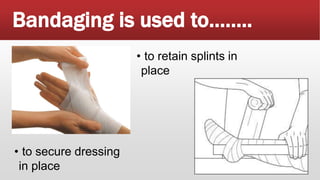GRADE 9 HEALTH --- Bandaging
- 3. BANDAGING PREPARED BY: RONALYN B. SOLIVEN
- 4. What is First Aid? ▪The immediate care given to a person/victim who has suddenly become ill or injured.
- 5. What is Bandaging ? ‚ñ™ a strip of material that protect wound or injured part of the patient.
- 6. Bandaging is used to…….. •support- fractured bone •immobilize- dislocated shoulder/jaw •apply pressure- stop bleeding and venous blood flow
- 7. Bandaging is used to…….. • to secure dressing in place • to retain splints in place
- 10. Parts of a Triangular Bandage
- 11. Cravat
- 12. Square Knot RIGHT over LEFT LEFT over RIGHT
- 19. Proper execution ---------------- 60% Bandage used --------------------- 30% Input of instruction -------------- 10% 100%
Editor's Notes
- Fracture – crack or breaking of the bone Immobilize - prevent (something or someone) from moving or operating as normal. Venous blood flow -  Blood that has passed through the capillaries of various tissues other than the lungs, is found in the veins, in the right chambers of the heart, and in pulmonary arteries, and is usually dark red as a result of a lower content of oxygen.
- A dressing is a clean pad or compress applied to a wound to promote healing and protect the wound from further harm. Splints - a strip of rigid material used for supporting and immobilizing a broken bone when it has been set
- Triangular – a piece of soft material that covers and protects an injured part of the body. consisting of a wide triangular piece of cloth hanging from around the neck. Tubular – A tube bandage is applied using an applicator, and is woven in a continuous circle. Gauze – (medicine) bleached cotton cloth of plain weave used for bandages and dressings. Compression - bandage that stops the flow of blood from an artery by applying pressure. 
- Size – 40”x40”x56” Apex - the uppermost point of the bandage
- Cravat – the technique of folding the triangular bandage forming a strip like structure to support the injured part of the victim.
- Square Knot - a type of double knot that is made symmetrically to hold securely and to be easy to untie. Right over left and Left over right

























